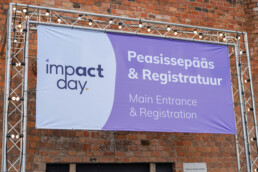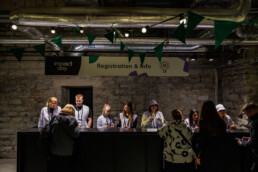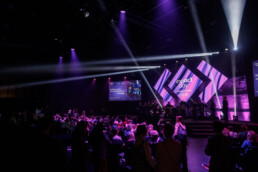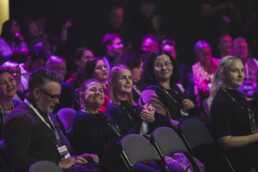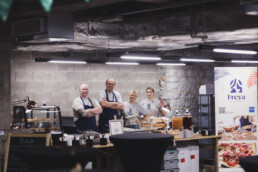Impact Day inspires once again
It has been a few weeks since Impact Day, so it is about time for a recap. This event is always well worth attending and highlights all topics relevant to a sustainable world. The beautiful old capital Tallinn is also a feast for the eyes. Although Estonia has only about 1.3 million inhabitants, Impact Day always has an international allure — not least because of the program with speakers from all over the world. Estonia is also known as one of the most digitally advanced countries, partly because it launched e-Residency in 2014. This allows you to run your business entirely online from anywhere and use all the services you need in Estonia.
Tallinn wants to be a leader in sustainability
It is also progressive in the field of circularity and other sustainability issues and wants to be a leader in this area. In 2023, Tallinn was still European Green Capital. But back to Impact Day, which actually consists of two days. How do you travel to such an event? From my base in Espoo – near Helsinki – in Finland, it’s extremely easy: you just take the boat and within two hours you’re sailing into the port of Tallinn. Although some ships are already equipped with more environmentally friendly technologies, the ecological balance of cruises remains significantly negative. Many shipping companies are working on electrifying their ships step by step, and there are also significant developments in the use of renewable fuels such as biodiesel, biogas, and hydrogen.
Sustainable ships in development
Eckerö Line’s m/s Finlandia, which sails between Helsinki and Tallinn, will be equipped with a battery solution to reduce CO2 emissions in early 2026, making it the first hybrid ship in the Gulf of Finland, although the intended fuel savings are only 3%. Nevertheless, this amounts to approximately 500-600 tons less fuel per year.
Program for the first day
The first day of Impact Day at Kultuurikatel, within walking distance of the port, kicked off with David Armstrong after a beautiful musical intro. He is a motivational speaker from the US and explained that your ‘Why’ must be greater than your ‘Why not’. Why do you get out of bed every day to do what you do? After a life full of struggles, he was able to put his finger on the sore spot like no other. Then it was the turn of Clover Hogan, a well-known Australian climate activist who was physically present last year, but now gave her opinion on the current state of sustainability issues via an online screen. How do you ensure that well-being, prosperity, and the environment go hand in hand? Which was basically the theme of the entire event: Building an Ambitious and Self-Sufficient Europe. One of the main organizers, Samuel Põldaru, smoothly tied everything together. And, just like last year, food and drinks were well taken care of.
Versatile topics
The rest of the day, various other interesting topics were discussed on the three stages — Impact Stage, Sustainability Stage, and Inspiration Stage — including reducing textile waste, the power of circularity, designing green cities, and reducing food waste. Although his advanced age (80) sometimes made him difficult to understand, the well-known Estonian zoologist and ethologist Aleksei Turovski stood out for me. His story, entitled ‘Animals Don’t Work for the Market. Are They Doomed?‘ was about the successful sustainable development of animal populations, which is inevitably linked to Shelford’s law: animals use resources and services in ecosystems on an optimal basis, not on a maximum basis.
This results in ecosystems that create a surplus — that is, more resources than the systems themselves need to thrive. This surplus is, for example, the thick layer of humus in the soil, the abundant oxygen in the air, and the peat in the swamp. It is what we humans have mistakenly come to take for granted and use at our own discretion. In reality, it is the only guarantee for the survival of biodiversity on earth. In light of current climate change, with countless animal species and entire coral reefs threatened with extinction, this is one of the most sensitive issues.
The day was concluded by Seth Godin, multiple bestselling author and marketing guru. He emphasized the importance of collaboration, local initiatives, and, last but not least, consistency. When you do things you truly believe in, something beautiful can emerge.
Program for day two
The second day began, once again, with beautiful musical accompaniment and a keynote speech by Gunter Pauli, a pioneer who is also known as the “Steve Jobs of sustainability”. He founded Zero Emissions Research and Initiatives (ZERI) in 1994 and is the author of The Blue Economy. He has also published 20 books in more than 30 languages and 365 fables: inspiring stories that introduce children to science and emotional intelligence. His story focused primarily on innovations and inspiration: there are now many more advanced methods and techniques available than wind and solar energy. And they are also cheaper, such as using ocean waves. This second day was also filled with interesting sessions: topics included food systems, the true value of sustainability, raw material use, the impact of AI, and growing with integrity. The latter is also the theme for next year: the new ROI, or Return on Integrity. That is exactly what is needed right now for the shift to a truly more sustainable world.
📷 The photos were taken by Laura Luga, Rasmus Kooskora, and Silver Gutmann.
ℹ️ Sustainability Content Agency is an ambassador of Impact Day and writes, edits, translates, and advises on sustainability, social impact, and health in almost all European languages. Contact us for more information or book a short call via Calendly.
